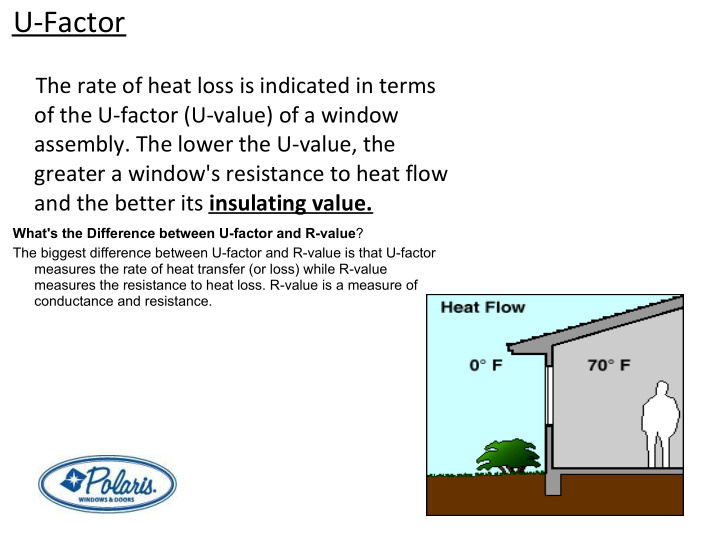



U-Factor The rate of heat loss is indicated in terms of the U-factor (U-value) of a window assembly. The lower the U-value, the greater a window's resistance to heat flow and the better its insulating value. What's the Difference between U-factor and R-value ? The biggest difference between U-factor and R-value is that U-factor measures the rate of heat transfer (or loss) while R-value measures the resistance to heat loss. R-value is a measure of conductance and resistance.
U-Value: Points to Ponder U-Value – Basically is insulating value. Heat flows from the warmer to the colder side of the window & frame is a complex interaction of all three heat transfer mechanisms Conduction, Convection & Radiation. A single glazed window has the insulating qualities as a sheet of metal. Can be considered a thermal hole in the wall and typically has a heat loss rate ten to twenty times that of an insulated wall.
U-Value: Points to Ponder U-Value of our Window = .3 Competors Window = ?????
Solar Heat Gain Coefficient (SHGC) The amount of Radiant heat that comes thru the window heating the objects and people up leading to discomfort The lower a window's solar heat gain coefficient, the less solar heat it transmits.
SHGC: Points to Ponder Heat is gained from Solar Radiation, regardless of outside temperature. Solar Heat Gain through windows tends to be the single most significant factor in determining the air- conditioning load.
SHGC: Ours= ??? SHGC:Thiers= ??? There is no SHGC Standard for this part of the country. WHY? How many days a year would you not want solor heat in your home?
How we use Energy Heating & Cooling Accounts for 45%!
The typical U.S. family spends more than $2,100 a year on home utility bills? Unfortunately, a large portion of that energy is wasted
Windows & Doors are the 2 nd leading cause of Air Infiltration in the home How air escapes
Heat Loss from a House A picture is worth...in this case, lost heating dollars. This thermal photograph shows heat leaking from a house during those expensive winter heating months. The white, yellow, and red colors show heat escaping. The red represents the area of the greatest heat loss.
Add up all the cracks It might be going out the window—literally. Most homes have enough leaks around windows and doors to equal a wide open three foot by three foot window! Source: US Department of Energy
Not all vinyl-framed windows are created equal. Some are insulated; some are not. Your Energy dollars could be leaking out of your window frames. At Polaris we fill our mainframes with ENIVIROMENTAL GREEN polyurethane foam. This is the same type of foam that is in your refrigerator which is the best insulating door in your home. Window mainframes insulated with ENVIRONMENTAL GREEN foam gives you: Increased energy savings ● Improved condensation resistance ● Increased home value ● Shown with optional foam filling
Thermo gram of 2 vinyl windows These two windows are the same except for what is inside the vinyl frames. The frame on the left is hollow, while the frame on the right is filled with insulating foam. The hollow window frame allows air to circulate inside the frame; this convective effect is observed by noticing the frame temperature. The foam-filled window doesn't show this effect. These windows are being cooled on the back side with wind at -15°C Thermo gram Source: Lawrence Berkeley National Laboratory
Air Leakage (AL) Is expressed in cubic feet of air passing through a square foot of window area (cfm/sq) per minute. The lower an (AL) number the less air a window will let in. When testing for (AL) the maximum allowed wind speed is 25 MPH.
Air Leakage: Points to Ponder When you get away from the protection of trees, shrubs and buildings Air leakage can be your leading cause of heat loss, heat gain in a window.
Air Leakage CFM @ 25 MPH 1 CFM 13 Gallons Per Minute 30 CFM Maximum 38.9 Gallons Per Minute
Air Leakage CFM @ 25 MPH UltraWeld Double Hung 1.3 Gallons Per Minute . 01 ● Virtually Air Tight ● Performs up to 30 times better than competitors
Recommend
More recommend